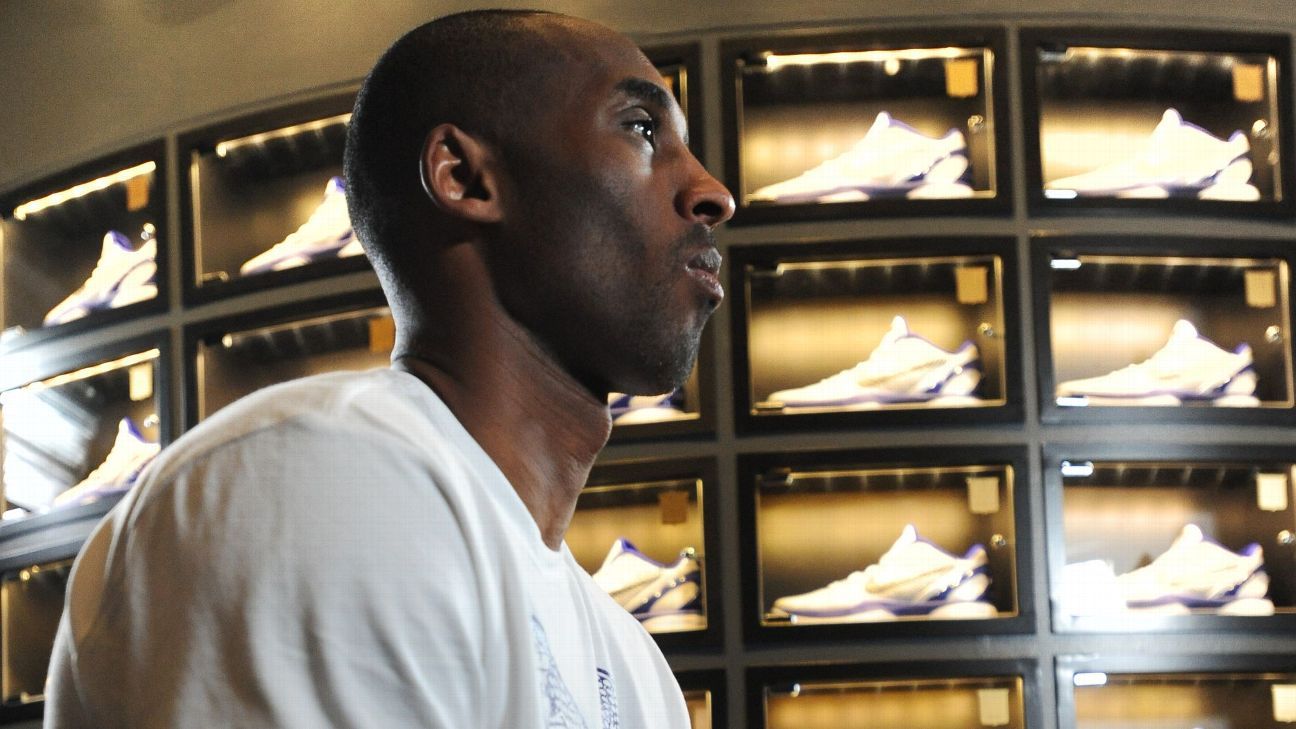This year’s Basketball Hall of Fame class is led by a trio of NBA legends: Kobe Bryant, Tim Duncan and Kevin Garnett. And while all three racked up countless on-court accolades, they also each enjoyed notable successes in the sneaker world.
In fact, this year’s group marks just the second time in league history that three or more players who had their own signature sneakers will be inducted into the Basketball Hall of Fame, joining the 2016 class that featured Allen Iverson, Yao Ming, Shaquille O’Neal and Sheryl Swoopes.
Bryant, Duncan and Garnett each represented a different style approach as they made their way into the league during the 1990s. And though they were never all on the companies’ rosters at the same time, all three wore Nike and Adidas sneakers at varying points of their careers. Their paths intersected in 2003, when all three made high-profile brand switches. Now, as they’re set to be enshrined in the Hall of Fame together later this summer, we look back at the sneaker journeys they went on during their legendary careers.
TIM DUNCAN: Nike, Adidas
The maxim that “big men can’t sell shoes” was well-established by the time Duncan was drafted No. 1 overall in 1997. Signature models for eventual Hall of Famers Shaquille O’Neal, Patrick Ewing and Dikembe Mutombo had underperformed at retail. Still, two of Duncan’s most memorable sneakers were the Nike models he laced up shortly after signing with the brand.
Just the fifth rookie of the decade to make an All-Star Game in his first season, Duncan debuted Nike’s black and white Foamposite Pro sneaker — a $170 follow-up to Penny Hardaway‘s instant classic Foamposite One model — at Madison Square Garden in 1998.
During the lockout-shortened 1998-99 season, Duncan donned the Total Foamposite Max, a gleaming metallic silver sneaker that may have been better suited for RoboCop, rather than San Antonio’s seemingly reserved power forward.
Tipping the scales at more than 20 ounces, they were clunky, but the molded flowing lines, iridescent collar logo circle and massive Air Max cushioning have made them a sought-after retro shoe. Though Duncan eventually received two oft-forgotten Nike signature sneakers of his own after winning the 1999 NBA championship, it’s the Total Foamposite Max that is most commonly remembered as “the Tim Duncans.”
Just as his time with Nike was coming to a sputtering halt, Duncan was peaking on the court, winning MVP honors in 2002. He signed with Adidas, wearing the Player’s Ball sneaker at the 2003 All-Star Game, and soon added another MVP award and a second championship.
More than a decade before Nike would launch its auto-lacing Adapt BB, Duncan debuted the industry’s first smart basketball sneaker, the Adidas_1 BB. Priced at a steep $250 and featuring a similar two-button adjustable computerized system, the technology adjusted the heel cushioning, rather than the fit of the entire shoe. The tech didn’t quite land and was never again seen in hoops.
Still, Duncan would go on to wear Adidas for the rest of his career. A staple of the company’s “It Takes 5” mantra and “Brotherhood” campaigns, Duncan traded in his D-Cool signature model to headline the brand’s many Team Signature models towards the end of his prime.
In the early 2010s, Duncan enjoyed perhaps his two biggest highlights with Adidas. He wore a skeletal exclusive of the TS Commander, featuring cartoonish bones along the top of the foot and underneath the shoe’s clear outsole.
He also was featured in a popular commercial in 2014, playing off the narrative that Duncan was boring. The ad shows the Spurs big man having a phone conversation with Derrick Rose, expressing his excitement over the brand’s upcoming launches in a deadpan monotone. It would be one of the final times Duncan was spotted in a commercial, with his Hall of Fame career wrapping up with subtle black and silver sneakers in the seasons to follow.
KEVIN GARNETT: Nike, AND1, Adidas, Anta
Garnett often credits a high school Nike camp in Indianapolis for taking him from an under-the-radar talent from South Carolina to the national stage, so it was no surprise when he signed a five-year sneaker deal with Nike as he went straight from high school to the NBA.
During his first 18 months in the league, Garnett rotated between the latest Flight and Uptempo models, even wearing Air Jordans and the new Jordan Brand’s earliest team editions. As the original Jordan Brand roster was being formed, Garnett’s name rose to the top of the list of potential candidates. However, the prospect of having his very own Nike signature shoe was too good to pass up.
He debuted the first Air Garnett at the ’98 All-Star Game, becoming just the 10th Nike player to have his own signature shoe. The Air Garnett 3 would go on to be his most memorable pair, with a bright blue fading mesh panel and bold black bordering lines against white leather.
“He is one of the most energetic people I know, and that’s where the outsole design comes in,” designer Aaron Cooper said. “It was inspired by a nuclear atom, something that radiates energy forever or for a very long time. So the bottom of the shoe was the energy source, the part of the shoe that powers off the floor, and that energy source radiates up the shoe through the mesh, making the entire shoe glow.”
But Garnett wanted more than a signature sneaker, and that desire drove his decision to leave Nike for AND1 in 2001. His new deal made him one of the league’s top-10-earning sneaker endorsers. AND1 also committed a healthy budget to high-production TV spots with revered directors and music producers. Of all his AND1 ads, none was more controversial and splashy than the Scarface-styled self-interrogation.
Though the final version was far tamer, a transcript from the set of Garnett interrogating himself and passionately answering back was published in ESPN The Magazine.
Launched in conjunction with his second AND1 Garnett sneaker in 2002, the commercial caught everyone’s attention, with Garnett receiving considerable criticism for his strong words. He had an out clause two years into his AND1 deal, and in part because of the reaction to the commercial, he took it.
Garnett landed with Adidas shortly after Duncan, with both of their signings facilitated in part because of Bryant’s departure from the brand during that same period. Garnett’s deal was proudly announced as a “lifetime” contract, though it would end up being much shorter.
Garnett’s run with Adidas was filled with disappointing signature models. He was later frustrated by the ending of his Garnett series, as the brand shifted to its Team Signature lineup and placed him in the same shoe as Duncan, Tracy McGrady, Dwight Howard and other players around the league.
Still, Garnett’s career-defining achievement came while wearing Adidas: his 2008 NBA championship with the Boston Celtics. For the Finals, the company made him a special edition shoe featuring the official Finals logo along the inside panels of the sneakers. Green stitching highlighted the individual game number of each pair worn by Garnett in the series, while the collar featured his face.
Just after helping lead the Celtics to another NBA Finals run in 2010, Garnett moved to his fourth brand, becoming the first All-Star player to sign with Chinese brand Anta. The deal lasted for the rest of Garnett’s career, expanding his brand in China and helping establish the company stateside.
“KG paved the way for us,” Anta executive Shawn Liu said. “We wanted to become better and better by working with the world’s top athletes.”
Garnett also helped create a bridge to other NBA stars, including Rajon Rondo, Gordon Hayward and signature star Klay Thompson.
“The announcement itself meant something, to show our shareholders and the market that Anta was serious in the basketball world,” Liu said.
KOBE BRYANT: Adidas, Nike
Adidas went all-in on Bryant, who declared “I want to be the next Michael Jordan” when he was 17 years old. After missing out on the first Jordan, Adidas didn’t want history to repeat itself, and it signed Bryant to a six-year deal right out of high school and gave him a signature sneaker, the Adidas KB8.
Featuring the brand’s ergonomic “Feet You Wear” technology, the shoe — now known as the “Crazy 8” — has been the company’s most recognizable basketball sneaker for the past two decades.
By the start of the 2000s, Adidas tapped auto manufacturer Audi to co-design Bryant’s The Kobe series. His first sneaker under the new direction was well-liked and was worn throughout the Lakers’ championship three-peat. The second shoe was one of the more polarizing and unpopular signature models ever released.
Bryant wasn’t a fan, and he wanted out. He paid back millions to Adidas as part of a complicated break clause and agreed to play the entire 2002-03 season without a shoe deal. Bryant couldn’t even wear the same brand three games in a row — leading to the first-ever period of “sneaker free agency” for a star player.
Bryant rotated through an exclusive batch of Laker-hued sneakers from the likes of Jordan, Nike, Converse, Reebok and AND1 until he landed a four-year, $40 million deal with Nike.
“It was like when Harry Potter landed in Hogwarts. He was home,” Bryant said years ago, with a laugh.
Almost instantly, Bryant formed a bond with designer Eric Avar that would shape the foundation and principles of his Nike series. The duo made their immediate mark with the Zoom Huarache 2K4, debuted in Los Angeles at All-Star Weekend in 2004. Bryant’s defining imprint on the sneaker industry was felt when he launched the Kobe 4, a low-top silhouette that shifted the look of footwear heights at all positions across the league.
He’d go on to win his first title without Shaquille O’Neal in the Kobe 4, before tacking on his final championship the following season in the Kobe 5. Bryant’s success validated the low-cut sneaker, taking the cut from a niche product to a leaguewide staple.
“Everyone knew that Kobe was involved, that his products represented a level of performance that he demanded,” Avar said. “He challenged himself, he challenged us, and he challenged Nike. At that point, there was almost an expectation of performance and expression with his product.”
While his idol Jordan’s groundbreaking signature series blurred the lines of performance and lifestyle, Bryant looked to take a different direction with his line after leaving the game in 2016.
His Kobe AD series pushed the limits of lacing, fit and construction. Bryant was insistent that before any of his prior models could be re-released that the technology and materials would need to be modernized, allowing players to wear the vintage looks in a high-performance sneaker. He even coined a new term for the shoes.
“Protro is about evolution and improving on things that were,” Bryant said when the first model was released. “I wanted to build a business that wasn’t just based on things I have done in the past. It is important that the brand stands for performance and that everything we do is innovative.”
This past season, more than 100 players wore the Kobe 4 Protro during an NBA game. While Duncan may have been known for his earliest sneakers and tongue-in-cheek approach to commercials, and Garnett for his business approach to the industry at every turn of his career, Bryant’s line looked to stand for innovation and performance first, building a runway for the series to live on well into the future.

